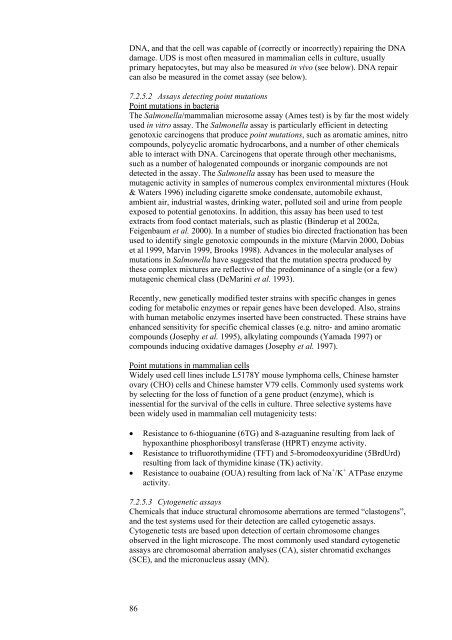Combined Actions and Interactions of Chemicals in Mixtures
Combined Actions and Interactions of Chemicals in Mixtures
Combined Actions and Interactions of Chemicals in Mixtures
You also want an ePaper? Increase the reach of your titles
YUMPU automatically turns print PDFs into web optimized ePapers that Google loves.
DNA, <strong>and</strong> that the cell was capable <strong>of</strong> (correctly or <strong>in</strong>correctly) repair<strong>in</strong>g the DNA<br />
damage. UDS is most <strong>of</strong>ten measured <strong>in</strong> mammalian cells <strong>in</strong> culture, usually<br />
primary hepatocytes, but may also be measured <strong>in</strong> vivo (see below). DNA repair<br />
can also be measured <strong>in</strong> the comet assay (see below).<br />
7.2.5.2 Assays detect<strong>in</strong>g po<strong>in</strong>t mutations<br />
Po<strong>in</strong>t mutations <strong>in</strong> bacteria<br />
The Salmonella/mammalian microsome assay (Ames test) is by far the most widely<br />
used <strong>in</strong> vitro assay. The Salmonella assay is particularly efficient <strong>in</strong> detect<strong>in</strong>g<br />
genotoxic carc<strong>in</strong>ogens that produce po<strong>in</strong>t mutations, such as aromatic am<strong>in</strong>es, nitro<br />
compounds, polycyclic aromatic hydrocarbons, <strong>and</strong> a number <strong>of</strong> other chemicals<br />
able to <strong>in</strong>teract with DNA. Carc<strong>in</strong>ogens that operate through other mechanisms,<br />
such as a number <strong>of</strong> halogenated compounds or <strong>in</strong>organic compounds are not<br />
detected <strong>in</strong> the assay. The Salmonella assay has been used to measure the<br />
mutagenic activity <strong>in</strong> samples <strong>of</strong> numerous complex environmental mixtures (Houk<br />
& Waters 1996) <strong>in</strong>clud<strong>in</strong>g cigarette smoke condensate, automobile exhaust,<br />
ambient air, <strong>in</strong>dustrial wastes, dr<strong>in</strong>k<strong>in</strong>g water, polluted soil <strong>and</strong> ur<strong>in</strong>e from people<br />
exposed to potential genotox<strong>in</strong>s. In addition, this assay has been used to test<br />
extracts from food contact materials, such as plastic (B<strong>in</strong>derup et al 2002a,<br />
Feigenbaum et al. 2000). In a number <strong>of</strong> studies bio directed fractionation has been<br />
used to identify s<strong>in</strong>gle genotoxic compounds <strong>in</strong> the mixture (Marv<strong>in</strong> 2000, Dobias<br />
et al 1999, Marv<strong>in</strong> 1999, Brooks 1998). Advances <strong>in</strong> the molecular analyses <strong>of</strong><br />
mutations <strong>in</strong> Salmonella have suggested that the mutation spectra produced by<br />
these complex mixtures are reflective <strong>of</strong> the predom<strong>in</strong>ance <strong>of</strong> a s<strong>in</strong>gle (or a few)<br />
mutagenic chemical class (DeMar<strong>in</strong>i et al. 1993).<br />
Recently, new genetically modified tester stra<strong>in</strong>s with specific changes <strong>in</strong> genes<br />
cod<strong>in</strong>g for metabolic enzymes or repair genes have been developed. Also, stra<strong>in</strong>s<br />
with human metabolic enzymes <strong>in</strong>serted have been constructed. These stra<strong>in</strong>s have<br />
enhanced sensitivity for specific chemical classes (e.g. nitro- <strong>and</strong> am<strong>in</strong>o aromatic<br />
compounds (Josephy et al. 1995), alkylat<strong>in</strong>g compounds (Yamada 1997) or<br />
compounds <strong>in</strong>duc<strong>in</strong>g oxidative damages (Josephy et al. 1997).<br />
Po<strong>in</strong>t mutations <strong>in</strong> mammalian cells<br />
Widely used cell l<strong>in</strong>es <strong>in</strong>clude L5178Y mouse lymphoma cells, Ch<strong>in</strong>ese hamster<br />
ovary (CHO) cells <strong>and</strong> Ch<strong>in</strong>ese hamster V79 cells. Commonly used systems work<br />
by select<strong>in</strong>g for the loss <strong>of</strong> function <strong>of</strong> a gene product (enzyme), which is<br />
<strong>in</strong>essential for the survival <strong>of</strong> the cells <strong>in</strong> culture. Three selective systems have<br />
been widely used <strong>in</strong> mammalian cell mutagenicity tests:<br />
• Resistance to 6-thioguan<strong>in</strong>e (6TG) <strong>and</strong> 8-azaguan<strong>in</strong>e result<strong>in</strong>g from lack <strong>of</strong><br />
hypoxanth<strong>in</strong>e phosphoribosyl transferase (HPRT) enzyme activity.<br />
• Resistance to trifluorothymid<strong>in</strong>e (TFT) <strong>and</strong> 5-bromodeoxyurid<strong>in</strong>e (5BrdUrd)<br />
result<strong>in</strong>g from lack <strong>of</strong> thymid<strong>in</strong>e k<strong>in</strong>ase (TK) activity.<br />
• Resistance to ouaba<strong>in</strong>e (OUA) result<strong>in</strong>g from lack <strong>of</strong> Na + /K + ATPase enzyme<br />
activity.<br />
7.2.5.3 Cytogenetic assays<br />
<strong>Chemicals</strong> that <strong>in</strong>duce structural chromosome aberrations are termed “clastogens”,<br />
<strong>and</strong> the test systems used for their detection are called cytogenetic assays.<br />
Cytogenetic tests are based upon detection <strong>of</strong> certa<strong>in</strong> chromosome changes<br />
observed <strong>in</strong> the light microscope. The most commonly used st<strong>and</strong>ard cytogenetic<br />
assays are chromosomal aberration analyses (CA), sister chromatid exchanges<br />
(SCE), <strong>and</strong> the micronucleus assay (MN).<br />
86

















